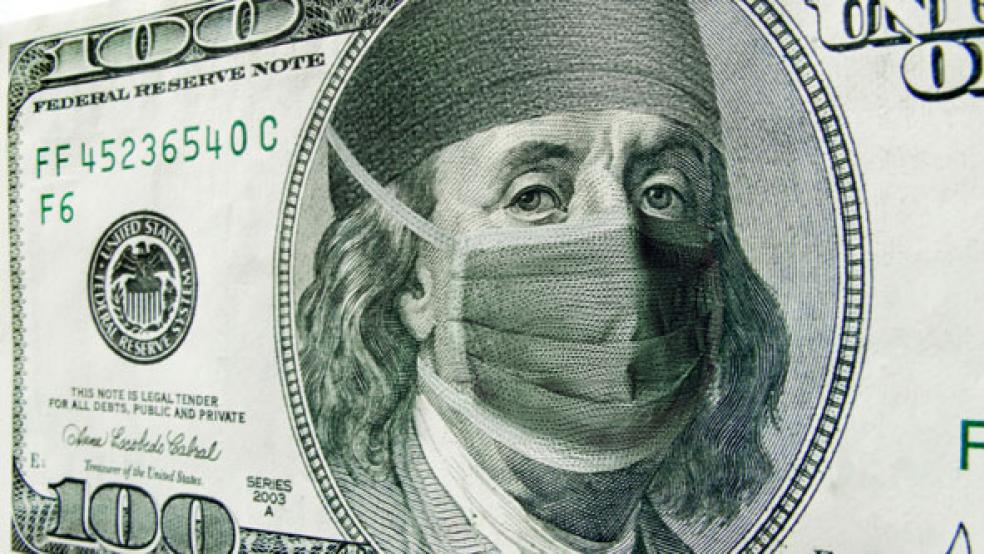For years America’s gold-plated healthcare system has provided little bang for the buck. In 2013, the U.S. outspent 13 other high-income countries on medical care – including Australia, Canada, Germany and Great Britain. Yet the U.S. had comparatively poor health outcomes, including a shorter life expectancy and greater prevalence of chronic conditions, according to a new study by the Commonwealth Fund.
Related: 4 Simple Ways to Save Money on Health Care
Based on the latest data from the Organization for Economic Cooperation and Development, the study showed that the United States spent $9,086 per capita on health care coverage -- or 17.1 percent of Gross Domestic Product -- in 2013. That was an astounding 50 percent more in spending as a percentage of the overall economy than in France, the next biggest spender with 11.6 percent of GDP.
Even so, the United States had far fewer practicing physicians than the median OECD country (2.6 versus 3.2 physicians per 1,000 population) and fewer hospital beds and fewer discharges per capita in the median OECD country. With the notable exception of a much lower than average mortality rate for caner, the comparative global picture remains disappointing for the U.S.
“Time and again, we see evidence that the amount of money we spend on health care in this country is not gaining us comparable health benefits,” Dr. David Blumenthal, president of the Commonwealth Fund, said in a statement. “We have to look at the root causes of this disconnect and invest our health-care dollars in ways that will allow us to live longer while enjoying better health and greater productivity.”
Of course, U.S. health care costs are not only inflated higher prices. Chronic diseases like obesity, alcohol and drug abuse, and gun violence can’t be blamed on the health care industry.
It’s important to note that the study’s data from OECD predates by a year the full implementation of the Obama administration’s Affordable Care Act. So it begs the question: how well have things gone under Obamacare?
Related: The Plot to Keep Health Care Prices from Consumers
The Brookings Institute has published an analysis of its own.
The Brookings’ Hamilton Project study notes that through a series of reform and vastly expanded access to health insurance plan, Obamacare has begun to dramatically reshape the delivery and cost of health care services to Americans in important ways. While some of these reforms are still taking hold -- and the program obviously has suffered serious missteps and growing pains -- the number of uninsured Americans dropped to 33 million or 10.4 percent of the population in 2014, the lowest it has been in years.
“The ACA’s mandate and corresponding subsidies for individuals to purchase health insurance on the federal or state exchanges explain some of the decline, but other economic forces, such as an improving labor market, may also be a factor,” the study says. Yet, with an estimated 35 million Americans still lacking health insurance and many more saddled with inadequate policies, “important gaps in the health-care safety net remain,” according to the report.
Related: Why Health Care Price Transparency May Not Work
Here are some of the study’s important findings:
- Spending on health-care varies greatly throughout the country. For instance, spending for the average Medicare enrollee in Miami is roughly 70 percent greater than in Minneapolis.
- Health-care spending has practically doubled as a share of GDP since the 1980s, but not due to consumers' out-of-pocket expenses. Several factors account for the growth in health-care expenditures, including the tilt in spending towards Medicare and Medicaid with an aging population.
- Millions of households with health insurance do not have enough cash on hand to pay out-of-pocket medical expenses in the event of a major health shock.
- Seniors on average are paying as much as 34 percent more than necessary for prescription drug coverage by choosing plans that are “not well-aligned with their needs.” Among elderly consumers choosing from Medicare Part D prescription plans through private insurers, they often end up paying five percent to 34 percent more for prescription drugs than if they had done a better job of shopping for a plan.
- The percentage of American workers enrolled in conventional health insurance programs has declined from 73 percent to less than one percent over the past 30 years. That’s because there has been a dramatic change in the types of employer-based health insurance plans being offered. Today, the preferred provider organization (PPO) health insurance plan is the most commonly purchased option and covers 58 percent of eligible employees.
- Finally, there has been a nearly 50 percent increase in the share of private sector workers who are offered a choice of health insurance plans during the past two decades. For instance, of the 116 million Americans who were working in the private sector in 2014, 56 percent were able to choose their health insurance plans from more than one employer-sponsored option.





